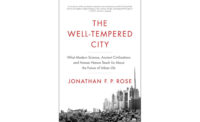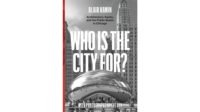Utopia by Design
When Paradise Planned arrived at my home—all 1,072 extra-thick high-gloss pages—my first instinct was to set the volume down on its own half-acre lot, give it a peaked roof, and simply move in. Instead, I rushed to the gym and spent a few days building up the biceps needed to lift the thing. Then, awed by the sheer cumulative industry of writing triumvirate Robert A.M. Stern, David Fishman, and Jacob Tilove, I lowered their exhaustive survey of the garden suburb onto my insufficient lap and started to read. I made it through by being selective, in much the same way some people flip past the threshing scenes in Anna Karenina to get to the main plot. If you quizzed me on Swedish bedroom communities in the early twentieth century, I might get a little vague. I know where to look it up, though.
All this bulk has a larger purpose: to prove overwhelmingly that the topic is not marginal or slight—that you can't fathom the modern city without understanding the immemorial longing for a house in a bower, just outside the city walls. The authors deploy industrial quantities of homework and buckets of elegant prose—not to mention maps, drawings, then-and-now snapshots, close-up details, and aerial views—to rescue a “tragically interrupted, 150-year-old tradition” from modern disrepute. This is not another treatise on sprawl; it's about the work of planners who believed, as Frederick Law Olmsted did, that well-ordered suburban settlements entwined with nature were the “most attractive, the most refined, the most soundly wholesome forms of domestic life.” (It didn't always work out that way, of course; you can feel the authors' frustration with harmoniously laid-out areas of Rio de Janeiro that were later hemmed in, overbuilt, and under-beautified.)
The story begins in England, where the 18th-century penchant for imposing Cartesian order on uncooperative nature merged with the opposite desire for the irrational and picturesque. The little Dorset town of Milton Abbas was charmingly arranged along a road by Capability Brown and his nemesis William Chambers, both to suit the local landowner and to make it seem as if the village had been that way since the days of Arthur. Fantasy and pretension have wafted through many suburban projects, but they can lead to spectacular results.
The engine of those developments was usually money but often idealism—or ideology, depending on your point of view. The writers escort us to the Italian coastal villages of Littoria and Sabaudia, which Mussolini conjured out of the malarial swamps south of Rome in the 1930s. They were triumphalist places, small towns with big squares so that the populace could turn out in the leader's praise. But they were also pleasant beach towns, sensitively knit to the low-slung landscape. (Stern has a soft spot for big plans, so dictators, lords, princes, and tycoons swagger through these pages, usually with good intentions, at least so far as urbanism goes.)
As every savvy politician knows, you don't win an argument with facts alone, so Stern and his wingmen have ornamented their case with cinematic vignettes and wry asides. We learn that George Merrick, the founder of Coral Gables, turned “an abandoned limestone quarry into a spectacular public swimming pool . . . where, on a floating raft, the portly bandleader Paul Whiteman, resplendent in a swimming suit and hat, conducted his jazz orchestra.” We cruise around the globe, making scenic stops for summaries that read like film treatments: a Hungarian soldier-architect escapes from Siberia to Shanghai, where he hooks up with a real estate company founded by a Californian huckster to build the leafy enclave called Columbia City.
The book pauses from time to time in its brisk march through hundreds of places, inviting readers to savor the pleasures of a particularly gracious few. We linger on the Regent's Development by John Nash, the winding corridor from St. James's Park to Regent's Park, which is now locked into the dense center of London but in the late 18th century made possible “both a real and a metaphoric journey from town to country.” Later, we amble through Olmsted's Riverside, Illinois, where gently curving streets enliven the flat topography and, in the designer's words, “imply leisure, contemplativeness, and happy tranquility.” Yet Riverside is an utterly modern product of the technology of speed: without quick rail access to downtown Chicago, it could never have been born.
Rather than alternate narrative and analysis, the book weaves the two together in long, sturdy ropes of prose. “With much of its land mass literally scooped up from the sea by Carl G. Fisher, who cut down the mangrove trees to two feet above ground, leaving the stumps in place, and pumped sand from the bottom of Biscayne Bay to a height of two feet to create new land, Miami Beach was the best known of the new resort city-suburbs, but not necessarily the best planned.” There's an awful lot packed into that sentence: a Citizen Kane–like real estate mogul arrogantly terraforming nature to his liking; a summary of a massive engineering feat; the origin myth of a familiar place; a taste of 'twenties marketing; and an understated critical swipe. Now multiply that density by all those pages, and you get some idea of the book's informative riches.
Paradise Planned closes with a full-throated paean to Celebration, Florida, the town that Disney built, for which Stern produced the master plan. It was a profoundly controversial project, a pastel projection of American optimism that rubbed plenty of people raw. But critics who “complained about the level of design control” were “ignorant of precedents such as Forest Hills Gardens, suggesting that this was something new and faintly fascistic.” Ah, so that's where the logic was headed all along: once enough urban thinkers understand the depth of the garden suburb tradition, they will naturally want to reclaim it. In the meantime, I defy anyone who so much as leafs through this book to sniff dismissively at a verdant enclave ever again.
Justin Davidson is the architecture and classical music critic for New York Magazine.








Post a comment to this article
Report Abusive Comment